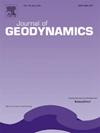New insights into the North Tabriz Fault from the analysis of third order stresses
IF 2.1
3区 地球科学
Q2 GEOCHEMISTRY & GEOPHYSICS
引用次数: 0
Abstract
The North Tabriz Fault (NTF) is a major regional fault traversing northwestern Iran. It persists through the Turkish-Iranian plateau crossing the central part of the Iranian-Azerbaijan region. This fault has paleo-seismological history, and has been responsible for many devastating earthquakes, which in historical times have destroyed the city of Tabriz at least twelve times. The NTF is a WNW–ESE trending strike-slip fault but also includes a thrusting component that runs for more than 100 km between the Khoy-Siyah Cheshme- Gaylato fault and the Zanjan fault systems. In this research, seismicity, remote sensing, and field data available for the NTF are studied. Specifically, the stress phases for the three main segments of this fault (Northern, Middle, and Southeast) are analyzed and their hazard potential is established. Numerous horsetail structures, generated by compression resulting from dextral offset movements along the faults, exist in the Misho and Shibly mountain ranges. The phases of the stress relating to the NTF segments are analyzed by the direct inversion stress-separation (Angelier method). That analysis, together with fault movement potential analysis, reveals that the southeast segment of the NTF has the highest potential to generate displacement, suggesting that this fault segment poses the highest risk for future large-scale earthquakes. Moreover, analysis of recent seismicity along the fault, including major earthquake events of 2023 in Southeast Turkey identify a gap in seismicity along part of the NTF, suggesting that future earthquakes should be expected in that region.
通过分析三阶应力对北大不里士断层的新认识
北大不里士断层(NTF)是一条穿越伊朗西北部的主要区域性断层。它持续穿过土耳其-伊朗高原,穿过伊朗-阿塞拜疆地区的中部。这个断层有古地震学的历史,是多次破坏性地震的原因,在历史上,大不里士市至少被摧毁了12次。NTF是一个WNW-ESE走向的走滑断层,但也包括一个在Khoy-Siyah Cheshme- Gaylato断层和Zanjan断层系统之间运行超过100 公里的逆冲成分。在这项研究中,研究了NTF的地震活动性、遥感和现场数据。具体来说,分析了该断层的北、中、东南三个主要断层段的应力相,并确定了它们的危险性。在米绍山脉和Shibly山脉中存在着大量的马尾构造,它们是由沿断层的右向偏移运动造成的压缩而形成的。采用直接反演应力分离法(Angelier法)分析了NTF段的应力相。该分析与断层运动潜力分析表明,NTF的东南段具有最大的位移潜力,表明该断层段未来发生大地震的风险最高。此外,对断层沿线近期地震活动的分析,包括2023年土耳其东南部的大地震事件,发现NTF部分地区的地震活动存在空白,这表明该地区未来可能会发生地震。
本文章由计算机程序翻译,如有差异,请以英文原文为准。
求助全文
约1分钟内获得全文
求助全文
来源期刊

Journal of Geodynamics
地学-地球化学与地球物理
CiteScore
4.60
自引率
0.00%
发文量
21
审稿时长
6-12 weeks
期刊介绍:
The Journal of Geodynamics is an international and interdisciplinary forum for the publication of results and discussions of solid earth research in geodetic, geophysical, geological and geochemical geodynamics, with special emphasis on the large scale processes involved.
 求助内容:
求助内容: 应助结果提醒方式:
应助结果提醒方式:


